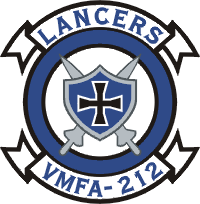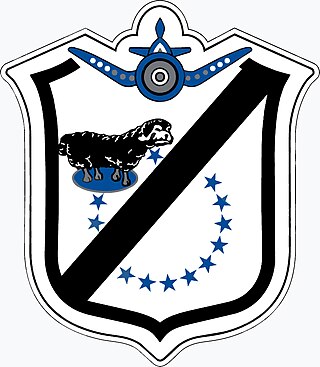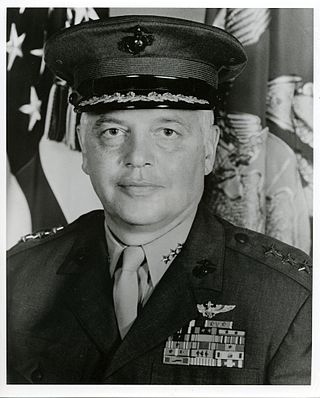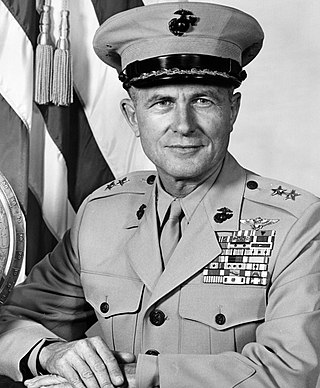
Marine Fighter Attack Squadron 212 (VMFA-212) was a United States Marine Corps F/A-18 Hornet squadron. Most recently known as the "Lancers", the squadron was last based at Marine Corps Air Station Iwakuni, Japan and fell under the command of Marine Aircraft Group 12 (MAG-12) and the 1st Marine Aircraft Wing. VMFA-212 has an extensive combat history having participated in combat operations during World War II, the Korean War, Vietnam War, the Gulf War, and Operation Enduring Freedom. Due to a re-organization within Marine aviation, the squadron was deactivated in 2008.

Marine Fighter Attack Squadron 214 (VMFA-214) is a United States Marine Corps fighter attack squadron that currently flies the Lockheed Martin F-35B Lightning II. The squadron's home field is Marine Corps Air Station Yuma, Arizona, and it is assigned to Marine Aircraft Group 13 (MAG-13) of the 3rd Marine Aircraft Wing.

Marine Fighter Attack Training Squadron 502 (VMFAT-502) is a United States Marine Corps fighter attack training squadron flying the Lockheed Martin F-35 Lightning II. Known as the "Flying Nightmares", the squadron maintains the history of Marine Attack Squadron 513 (VMA-513) which dates back to World War II and was decommissioned on 12 July 2013. The squadron is based at Marine Corps Air Station Miramar and falls under the command of Marine Aircraft Group 11 and the 3rd Marine Aircraft Wing

Marine Medium Tiltrotor Squadron 161 (VMM-161) is a United States Marine Corps tiltrotor squadron that operates the MV-22 Osprey. The squadron, known as the "Greyhawks", is based at Marine Corps Air Station Miramar, California and falls under the command of Marine Aircraft Group 16 (MAG-16) and the 3rd Marine Aircraft Wing. The squadron has the distinction of being the first helicopter transport squadron in the world and regularly utilizes the phrase "The First, The Best".

Marine Heavy Helicopter Squadron 462 (HMH-462) is a United States Marine Corps helicopter squadron operating CH-53E Super Stallion heavy transport helicopters. The squadron, known as the "Heavy Haulers", is based at Marine Corps Air Station Miramar in California and falls under the command of Marine Aircraft Group 16 (MAG-16) and the 3rd Marine Aircraft Wing.

Marine Medium Tiltrotor Squadron 268 (VMM-268) is a United States Marine Corps helicopter squadron consisting of MV-22 transport. The squadron, known as the "Red Dragons", is based at Marine Corps Base Hawaii, Kaneohe, Hawaii and falls under the command of Marine Aircraft Group 24 (MAG-24) and the 1st Marine Aircraft Wing.

Marine Aircraft Group 41 (MAG-41) is a United States Marine Corps reserve aviation unit based at Naval Air Station Joint Reserve Base Fort Worth, Texas that is currently composed of one F/A-18C squadron, one KC-130J squadron, one C-40 squadron, two Northrop F-5 aggressor squadron based at Marine Corps Air Station Yuma, Arizona and Marine Corps Air Station Beaufort, South Carolina, one Marine Light Attack Helicopter Squadron at MCAS Camp Pendleton, one MV-22B squadron based at MCAS Miramar, one aviation logistics squadron and two wing support squadrons with multiple detachments throughout the United States.

Marine Fighter Attack Training Squadron 501 (VMFAT-501) is a training squadron in the United States Marine Corps, consisting of 27 F-35B Lightning II aircraft and serves as the Fleet Replacement Squadron. Known as the "Warlords," the squadron is based at Marine Corps Air Station Beaufort, South Carolina and falls administratively under Marine Aircraft Group 31 and the 2nd Marine Aircraft Wing. The squadron has assumed the lineage of VMFA-451 which was originally known as the "Blue Devils" and saw action during World War II and Operation Desert Storm. They were decommissioned on 31 January 1997.

Marine Medium Tiltrotor Squadron 164 (VMM-164), is a United States Marine Corps tiltrotor squadron operating the MV-22B Osprey. Known as the Knightriders, they fall under the command Marine Aircraft Group 39 (MAG-39) and the 3rd Marine Aircraft Wing. They are based at Marine Corps Air Station Camp Pendleton.

John Lucian Smith was an American Medal of Honor recipient and Marine Corps flying ace who, as commanding officer of VMF-223, shot down 19 Japanese planes in World War II and led his squadron to destroy a total of 83 enemy aircraft during the Solomon Islands campaign.

Lieutenant General George C. Axtell was a United States Marine Corps general officer, a World War II flying ace, and a Navy Cross recipient. During World War II, he was the youngest commanding officer of a Marine fighter squadron. He also served in the Korean War and Vietnam War.

Marine Aircraft Group 49 is a United States Marine Corps Reserve aviation unit based at Joint Base McGuire–Dix–Lakehurst, New Jersey that is currently composed of squadrons that fly the MV-22B, CH-53E, AH-1Z, UH-1Y, UC-35D and UC-12F/W aircraft as well as an Aviation Logistics Squadron and Wing Support Squadron.

John Kerry Davis, also known as J.K. Davis, was a United States Marine Corps four-star general. Davis, a Vietnam War veteran and naval aviator, served as the Commanding General of the 3rd Marine Aircraft Wing (1977–1978) and the 1st Marine Aircraft Wing (1978-1978). His final assignment was as the Assistant Commandant of the Marine Corps from July 1, 1983, to June 1, 1986.

Marine Corps Air Station Camp Pendleton or MCAS Camp Pendleton is a United States Marine Corps airfield located within Marine Corps Base Camp Pendleton. It was commissioned in 1942 and is currently home to Marine Aircraft Group 39. The airfield is also known as Munn Field in honor of Lieutenant General John C. "Toby" Munn, the first Marine aviator to serve as the Commanding General of Marine Corps Base Camp Pendleton.
Hal Wellman Vincent was a naval aviator in the United States Marine Corps who retired at the rank of major general. A veteran of the Vietnam War, he commanded at the squadron, group and wing level during his career. He flew more than 10,000 hours in over 165 different aircraft and was the first Marine Aviator to fly Mach 2.0.

Robert Gordon Owens Jr. was a highly decorated United States Marine aviator and Major General, who was a flying ace with seven victories during World War II. He was a recipient of the Navy Cross, the United States' second-highest decoration awarded for valor in combat.

Robert Prescott Keller was a highly decorated Naval aviator in the United States Marine Corps with the rank of lieutenant general. He began his career as reserve pilot during World War II; he shot down one enemy aircraft and damaged two others during New Britain campaign. Keller distinguished himself again as pilot during Korean War and later reached general's rank during Vietnam War.

Edward Colston Dyer was a brigadier general in the United States Marine Corps who served in both World War II and the Korean War. A naval aviator and communications engineer, during his career he was a pioneer in the Marine Corps' development of early warning radar, night fighters, and helicopters.

Frank Christian Lang was a highly decorated officer in the United States Marine Corps with the rank of major general. A veteran of three wars, Lang began his career as fighter pilot in World War II and rose to the command of Marine Aircraft Group during the Vietnam War. Lang was promoted to the general's rank following the war and held several important assignments including command of 1st and 3rd Marine Aircraft Wings. He completed his career as Deputy Commander, Fleet Marine Force, Pacific in 1978.

John Pomeroy Condon was a highly decorated aviator in the United States Marine Corps with the rank of major general. He distinguished himself successively during World War II and Korea and completed his career as commanding general, 3rd Marine Aircraft Wing in October 1962.




















